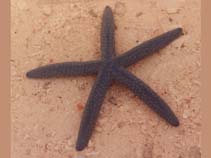Linckia laevigata (Linnaeus, 1758)
Blue linckia| Native range | All suitable habitat | Point map | Year 2050 |

|
| This map was computer-generated and has not yet been reviewed. |
| Linckia laevigata AquaMaps Data sources: GBIF OBIS |
Classification / Names Common names | Synonyms | CoL | ITIS | WoRMS
Asteroidea | Valvatida | Ophidiasteridae
Environment: milieu / climate zone / depth range / distribution range Ecology
Reef-associated; depth range 0 - 60 m (Ref. 800). Tropical
Distribution Countries | FAO areas | Ecosystems | Occurrences | Introductions
Indo-Pacific.
Length at first maturity / Size / Weight / Age
Maturity: Lm ? range ? - ? cm Max length : 40.0 cm WD male/unsexed; (Ref. 800)
Occurs in shallow reef areas exposed to the sunlight, on rocks, dead coral or rubble at depths of 0 to 60 m (Ref. 800). Also on a reef slope (Ref. 97449); among sponges, macroalgae and seagrasses (Ref. 82802). Juveniles hide under corals and rocks. Feeds on detritus, small invertebrates living on algal mats and dead animals (Ref. 800). Associated with coral communities. Likely feeds on turf algae and bacterial film over hard substrates (Ref. 129602).
Life cycle and mating behavior Maturity | Reproduction | Spawning | Eggs | Fecundity | Larvae
Members of the class Asteroidea exhibit both asexual (regeneration and clonal) and sexual (gonochoric) means of reproduction. Life cycle: Embryos hatch into planktonic larvae and later metamorphose into pentamorous juveniles which develop into young sea stars with stubby arms.
Main reference
References | Coordinator | Collaborators
Schoppe, S. 2000. (Ref. 800)
IUCN Red List Status (Ref. 130435)
CITES status (Ref. 108899)
Not Evaluated
CMS (Ref. 116361)
Not Evaluated
Threat to humans
Harmless
Human uses
| FishSource |
Tools
More information
Internet sources
BHL | BOLD Systems | CISTI | DiscoverLife | FAO(Publication : search) | Fishipedia | GenBank (genome, nucleotide) | GloBI | Gomexsi | Google Books | Google Scholar | Google | PubMed | Tree of Life | Wikipedia (Go, Search) | Zoological Record
Estimates based on models
Preferred temperature
(Ref. 115969): 24.2 - 29, mean 27.8 (based on 1194 cells).
Price category
(Ref. 80766):
Unknown.



